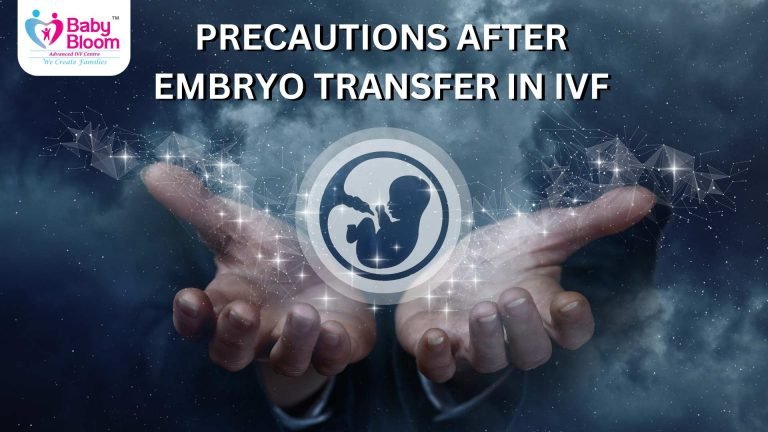Positive Signs After Embryo Transfer: Early Symptoms of IVF Success

Dr. Pujil Gulati, IVF Specialist with over 13 years of experience in Assisted Reproductive Techniques BabyBloom IVF Gurgaon
Introduction
Embryo transfer is one of the most crucial steps in the In Vitro Fertilization (IVF) process. After this stage, every couple eagerly waits to see if the procedure has been successful. While the best way to confirm pregnancy is through a blood test after 10–14 days, some early signs can indicate a successful implantation.
In this article, we will discuss the positive signs after embryo transfer, the early symptoms of IVF success, and what you should expect during this critical time.

What Happens After Embryo Transfer?
After the embryo is placed inside the uterus, it begins the process of implantation. If implantation is successful, the embryo attaches to the uterine lining and starts growing, leading to pregnancy.
The first few days after embryo transfer are crucial, as the body starts responding to the implanted embryo. Many women experience certain early pregnancy symptoms during this period, which may indicate that the IVF cycle has been successful.
Positive Signs After Embryo Transfer
(Early Pregnancy Symptoms After IVF)
Here are some common positive symptoms that may indicate a successful embryo transfer:
1. Light Spotting or Implantation Bleeding
✔️ What it means: This is one of the first signs of pregnancy after IVF. Light spotting or mild bleeding (pink or brown in color) can occur when the embryo attaches to the uterine wall.
✔️ When does it happen? Around 6 to 12 days after embryo transfer.
✔️ Is it normal? Yes, implantation bleeding is completely normal and usually lasts for a day or two
2. Mild Cramping
- ✔️ What it means: Some women feel mild cramps similar to period pain. This happens due to embryo implantation.
- ✔️ When does it happen? Usually 3 to 5 days after embryo transfer.
- ✔️ Is it normal? Yes, mild cramping is normal. However, severe cramps may require medical attention.

3. Increased Basal Body Temperature (BBT)
- ✔️ What it means: A slight increase in body temperature due to rising progesterone levels is a positive sign of pregnancy.
- ✔️ When does it happen? Within a few days after embryo transfer.
- ✔️ Is it normal? Yes, a slightly elevated temperature is normal, but a fever is not.
4. Breast Tenderness and Soreness
- ✔️ What it means: Hormonal changes after implantation can make the breasts feel fuller, tender, or sore.
- ✔️ When does it happen? Around 7 to 10 days after embryo transfer.
- ✔️ Is it normal? Yes, but breast soreness can also be a side effect of progesterone medication.
5. Fatigue and Tiredness
- ✔️ What it means: Increased levels of progesterone can cause tiredness and exhaustion.
- ✔️ When does it happen? Within the first week after embryo transfer.
- ✔️ Is it normal? Yes, fatigue is a common early pregnancy symptom.
6. Nausea or Morning Sickness
- ✔️ What it means: Rising pregnancy hormones (hCG) may cause mild nausea or sensitivity to smells.
- ✔️ When does it happen? Usually after 10 to 14 days, but some women experience it earlier.
- ✔️ Is it normal? Yes, but not every woman experiences nausea.
7. Increased Urination
- ✔️ What it means: Pregnancy hormones can cause frequent urination.
- ✔️ When does it happen? Around 7 to 10 days after embryo transfer.
- ✔️ Is it normal? Yes, but if accompanied by burning or pain, consult a doctor.
8. Bloating and Gas
- ✔️ What it means: Progesterone relaxes the digestive tract, leading to bloating and gas.
- ✔️ When does it happen? Within a week after embryo transfer.
- ✔️ Is it normal? Yes, but excessive bloating should be checked by a doctor.
9. Mood Swings
- ✔️ What it means: Hormonal changes can cause emotional ups and downs.
- ✔️ When does it happen? Anytime after embryo transfer.
- ✔️ Is it normal? Yes, but extreme mood swings should be discussed with a doctor.
10. Missed Period
- ✔️ What it means: A missed period is one of the strongest signs of pregnancy.
- ✔️ When does it happen? If the period does not start 14 days after embryo transfer, pregnancy is likely.
- ✔️ Is it normal? Yes, but a blood test is needed for confirmation.
How to Confirm IVF Success?
Even if you experience these positive signs after embryo transfer, the best way to confirm pregnancy is through a beta hCG blood test.
When to Take a Pregnancy Test After Embryo Transfer?
✅ Blood Test (Beta hCG Test) – 10 to 14 days after embryo transfer
✅ Home Pregnancy Test (Urine Test) – Not always reliable due to medications
What If You Don’t Have Any Symptoms?
🚨 No symptoms? Don’t panic! Many women do not experience any early pregnancy signs but still have a successful IVF cycle. The absence of symptoms does not mean IVF has failed.
What to Do After Embryo Transfer? (Dos & Don’ts)
✅ Dos:
- ✔️ Rest and avoid heavy physical activities.
- ✔️ Stay hydrated and eat a balanced diet.
- ✔️ Follow doctor’s advice and take prescribed medications.
- ✔️ Manage stress with meditation or light activities.
❌ Don’ts:
- ❌ Avoid alcohol, smoking, and caffeine.
- ❌ Do not lift heavy objects or engage in strenuous exercise.
- ❌ Avoid taking pregnancy tests too early to prevent stress.
Final Thoughts: Stay Positive & Patient!
The waiting period after embryo transfer can be emotionally challenging, but staying calm, positive, and patient is essential. Experiencing early symptoms of IVF success is a good sign, but the only way to confirm pregnancy is through a blood test.
If you are undergoing IVF, trust the process and follow your doctor’s guidance. Every journey is unique, and a successful outcome is possible!
FAQs About IVF Success Signs
- How soon after embryo transfer do pregnancy symptoms start?
👉 Some women experience symptoms within a few days, while others notice them after 10 to 14 days. - Can I get a negative pregnancy test but still be pregnant?
👉 Yes, early testing can give false negatives. A blood test is more reliable. - Is it normal to have no symptoms after embryo transfer?
👉 Yes, some women have a successful pregnancy without any early signs. - Can stress affect implantation?
👉 Extreme stress may impact implantation, so staying calm is important.
Write your message:-

Social Media Links :-
Welcome to BabyBloom IVF, where your journey to parenthood is nurtured with care, expertise, and the latest advancements in fertility treatment. Located in the heart of Gurgaon, Babybloom IVF is the Best IVF Centre in Gurgaon & leading fertility center dedicated to helping couples achieve their dreams of starting or growing their families.
Contact Us
Address No.1 I, block, 189, near Baani Square, South City II, Sector 50, (Gurgaon) Gurugram, Haryana 122018
Address No.2 Babybloom IVF, Nursing Home, Civil Rd, Company Bagh, Rohtak, Haryana 124001

Brought Happiness to the world
@BabyBloom IVF All Rights Reserved @2025


